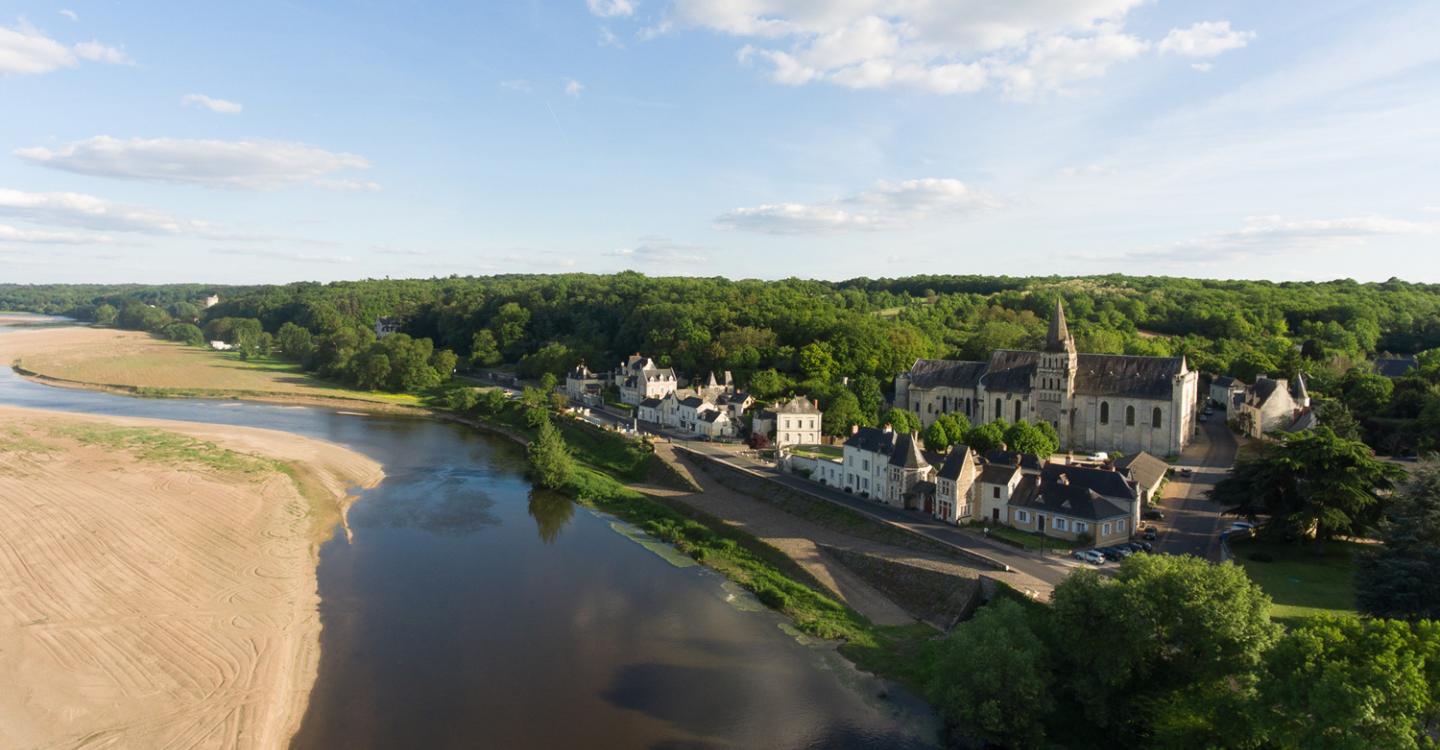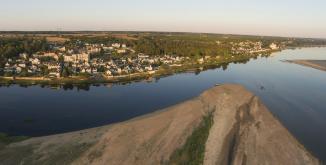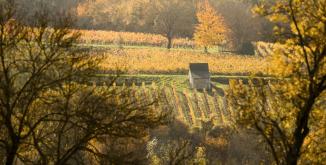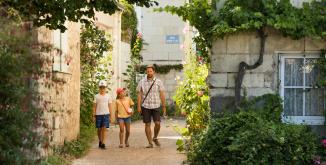You can find many religious buildings on the Park territory - such as the Fontevard abbey. They are a heritage from the religious communities who settled in the region from the 5th century on. All through the Middle Ages, these religious communities are at the heart of agricultural, artistic and intellectual development. They order the clearance of forests to set up livestock farming and cultivations. Placing their own orders, they encourage the development of arts and crafts.
The oldest monastic foundations date back to the first centuries of Christianity: the priory of Cunault, the abbey of St-Mexme de Chinon, the abbey of Saint-Maur-de-Glanfeuil. The most powerful ones are the abbeys of Bourgueil, Saint-Florent-lès-Saumur and Fontevraud.
The economic and demographic growth of the region give birth to the first villages. Each one is built around its church. Many of these buildings are still standing today: their Roman or Gothic façades invite the visitor to time travel. Roman and Gothic art is present all-over Western Europe, but has developed some local specificities:
- Roman art (from the 5th to second half of the 12th centuries) is marked by foreign influences coming mainly from the South via the Vienne and Thouet river. Sculptors are inspired by works from Poitou and Saintonge (former province of Aquitaine). On the local level, Roman art is real “fusion art”. The most beautiful examples are the Notre-Dame-de-Cunault church, the Roman Saint-Nicolas church in Tavant or the Saint-Léonard priory in L’Ile-Bouchard. The domes of the abbey of Fontevraud look very much alike the ones of the cathedral in Angoulême ...
- Local Gothic art (from the 12th to the 15th centuries) is very original: domed ogival vaults are typical of the local style. The collegiate churches of Candes-Saint-Martin and Puy-Notre-Dame, the Saint-Pierre church in Saumur, the Saint-Maurice church in Chinon or the Saint-Germain church in Bourgueil are the main monuments built during this period.
The Renaissance period (from the end of the 15th to the 16th centuries) leaves more architectural master pieces such as the Sainte Chapelle of Champigny-sur-Veude with its fantastic stained-glass windows.
In the 17th century, the Counter-Reformation marks the arrival of Classical architecture. The royal chapel of Notre-Dame des Ardilliers in Saumur and its huge rotunda best illustrates this period. In the 19th century, the wealthy Loire valley sees the construction of imposing neoclassical buildings such as the churches of Saint-Clément-des-Levées or Saint-Mathurin-sur-Loire.
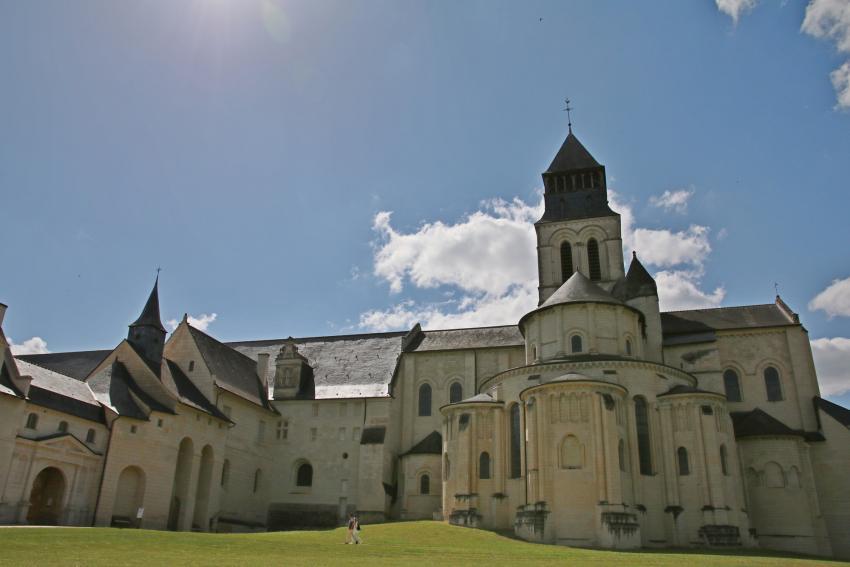
The economic role of monasteries in the Middle Ages
Monasteries play a crucial role in the development of the area. They get support and protection from local lords who also assign land to them. The implantation of monasteries makes people settle and build the first villages. At their initiative, alluvial forests near the rivers and streams are cleared in the 12th century to make room for livestock farming and other forms of agriculture.
Monasteries build tithe barns to store their share of the harvest. Peasants pay their rent (also called tithe) in kind. A tithe corresponds to about 10 percent of the harvest. The barns of Trèves and Cunault, in Saint-Clément-des-Levées, as well as the barn of Plessis-aux-Moines in Chouzé-sur-Loire are the last witnesses of this practice.
But the economic role of monasteries goes even further: they collect taxes and fees on goods sold during market days or transiting on the Loire. This money is used for constructing and maintaining religious and commercial buildings as well as civil engineering structures such as bridges.
The influence of the religious communities is significant. The abbess of the order of Fontevraud for example is head of a network which reaches out all the way to England and Spain! Only the French Revolution stops this influence with the order being dissolved and the abbey transformed into a prison.
Roman art at the confluence
Original local forms of art and architecture, marked by influences from Poitou and Saintonge or even Berry start to develop in the 11th century. The great number of overland and river routes crossing the territory (of the Loire-Anjou-Touraine Park today) make exchanges of all kind easier – also for art and culture.
The different influences are well visible on some of the masterpieces dating back to the Roman period:
- The Notre-Dame priory of Cunault imitates Roman sculptures from the South-West. The collection of 223 capitals is the region’s most impressive one.
- The abbatial church of Fontevraud has a nave with a line of domes built in the 12th century, clearly inspired by the cathedral of Angoulême. The decoration contains the recumbent figures of Henri II Plantagenêt, Aliénor of Aquitaine, Isabelle of Angoulême and Richard Lionheart.
- Only little is left the Saint-Léonard priory in L'Ile-Bouchard, but you can still see the remarkable sculptured capitals done just like in Poitou.
- The small crypt of the Saint-Nicolas church in Tavant is also worth a detour. It is covered with mural paintings dating back to the 12th century, well-known all over France.
The richness and diversity of Roman art can be observed on these masterpieces of architecture as well as on many other smaller religious constructions on the territory.
The charm of rural villages in the Loire-Anjou-Touraine Park is very much due to this multitude of small buildings, like for example: the Roman towers of Saint-Georges-du-Bois, Saint-Georges-des-Sept-Voies or Saint-Germain-sur-Vienne, the twisted spire of Fontaine-Guérin, the Roman frescos of the Saint-Martin church in Lignières-de-Touraine, the churches of Blou, Brion or Parçay-sur-Vienne, ...
The specificity of Gothic art made in Angers
In the middle of the 12th century, Roman art is replaced by Gothic art, which first appears in the Paris area. In western France (Anjou-Maine-Touraine-Poitou), it should undergo a special development and even become a very particular style.
Gothic art in the West of France (also called “Plantagenet style”) is famous for its strongly domed ogival vaults, more domed than in the churches of the Île-de-France. You can recognise the specific influence of the Roman copulas of the South-West.
Religious monuments are most commonly composed of a single nave, without side aisles. Most of the time, the churches have flat chevets, without apse or ambulatory, like in Bourgueil, Saint-Germain-sur-Vienne or Sazilly.
The ogives help to better dispatch the weight of the vault and to lighten the framework of religious buildings. But Gothic art, Plantagenet style, pushes this impression of lightness even further: the usual flying buttresses are replaced by simple buttresses and the vault’s ribs get finer and finer.
In the Gothic art of Western France, the sobriety of outside walls is a strong contrast to the elegance of the keystones and the sculptured capitals. You have to push the doors of the buildings to discover the whole beauty of it! The most remarkable buildings of the territory are:
- The collegiate church of Candes-Saint-Martin: this pilgrimage church is certainly one of the most beautiful examples of this period. It has a nave with two side aisles and a porch opening to the Vienne river.
- The Saint-Pierre church in Saumur and the Saint-Maurice church in Chinon appear by the most beautiful urban buildings of Plantagenet style.
- The collegiate church of Puy-Notre-Dame: dominating the vineyards from its rocky promontory, this church appears like a cathedral accidently built in the middle of the countryside.
Patron saints and professional corporations
In the Loire valley, bargees pray many saints. Saint Clement for example, the patron saint of the sailors, and Saint Nicolas. Quarrymen leave it to Saint Peter: you can find his effigy in many churches of the Saumur parish, an era with many tufa and shelly sand quarries. Saint Peter sometimes also is the patron saint of the Loire fishermen.
But the great protectress of the valley, its plantations and in habitants is the Virgin Mary. She is everywhere: in big shrines and small oratories (small so-called “sailors” chapels) of the villages along the Loire levee. The collegiate church of Notre-Dame du Puy-Notre-Dame, the church of Notre-Dame de Nantilly and the royal chapel of Notre-Dame des Ardilliers in Saumur used to be important pilgrimage places to the glory of the Virgin in the West of France.
In the churches of La Chapelle-sur-Loire and Chouzé-sur-Loire, you can admire another expression of the bargees’ faith: model boats hanging down from the vault, dating back to the 19th century. They are so-called “ex-voto”, votive offerings to ask or thank for mercy. In Chênehutte, two gifts take centre stage: one altar candle decorated with a Loire boat, donated by sailors; and another altar candle decorated with a stonemason, donated by the quarries.
These guilds have unshakable faith. Nothing is too good for decorating religious monuments. In the second half of the 19th century, basket makers from Villaines-les-Rochers and their priest provide the Saint-André church with sumptuous mural paintings. They realise their project thanks to financial aid from Empress Eugenie, a fervent Catholic and art lover.

